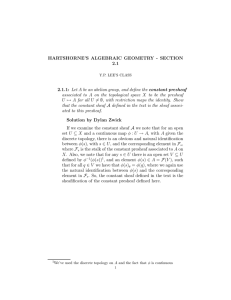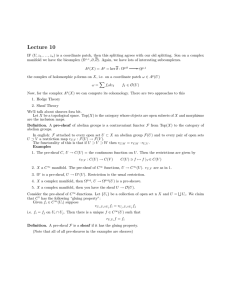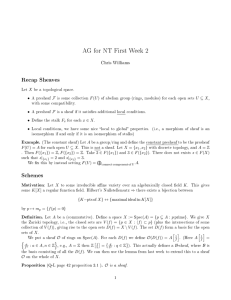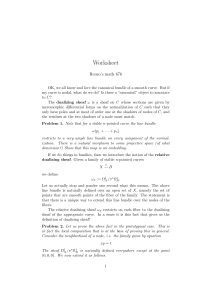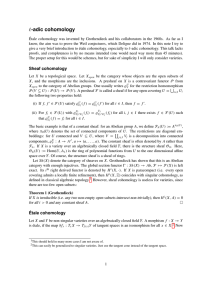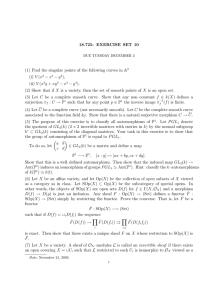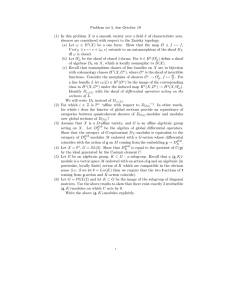PROBLEMS: TOPICS IN ALGEBRAIC GEOMETRY AND GEOMETRIC REPRESENTATION THEORY
advertisement
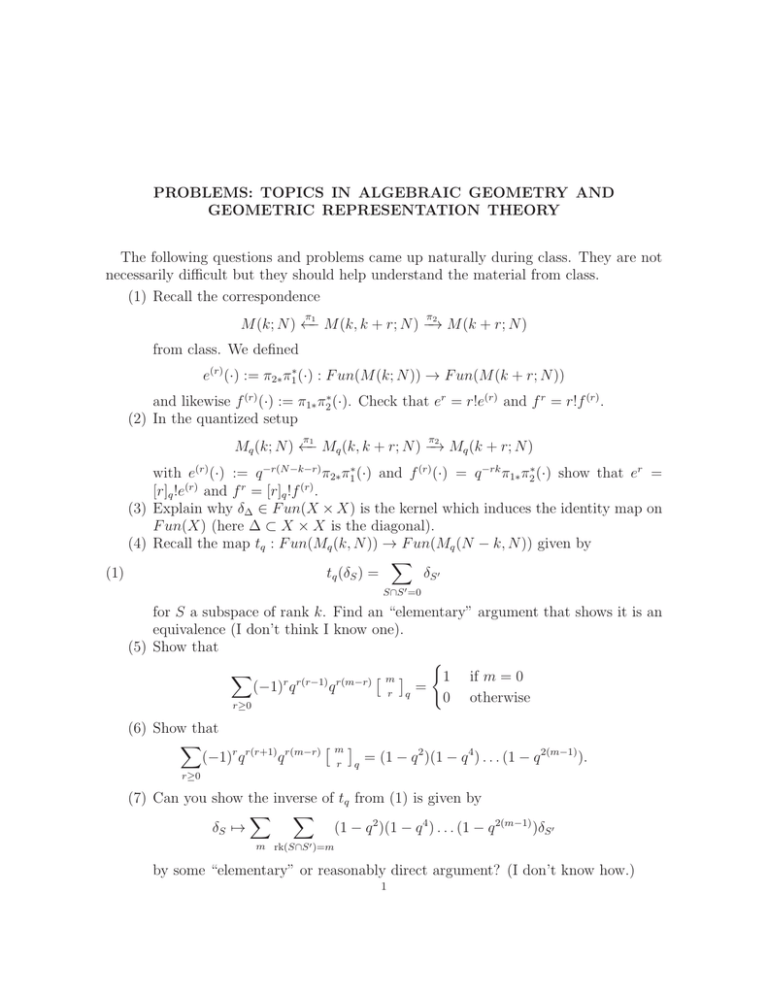
PROBLEMS: TOPICS IN ALGEBRAIC GEOMETRY AND
GEOMETRIC REPRESENTATION THEORY
The following questions and problems came up naturally during class. They are not
necessarily difficult but they should help understand the material from class.
(1) Recall the correspondence
π
π
2
1
M (k + r; N )
M (k, k + r; N ) −→
M (k; N ) ←−
from class. We defined
e(r) (·) := π2∗ π1∗ (·) : F un(M (k; N )) → F un(M (k + r; N ))
and likewise f (r) (·) := π1∗ π2∗ (·). Check that er = r!e(r) and f r = r!f (r) .
(2) In the quantized setup
π
π
2
1
Mq (k + r; N )
Mq (k, k + r; N ) −→
Mq (k; N ) ←−
with e(r) (·) := q −r(N −k−r) π2∗ π1∗ (·) and f (r) (·) = q −rk π1∗ π2∗ (·) show that er =
[r]q !e(r) and f r = [r]q !f (r) .
(3) Explain why δ∆ ∈ F un(X × X) is the kernel which induces the identity map on
F un(X) (here ∆ ⊂ X × X is the diagonal).
(4) Recall the map tq : F un(Mq (k, N )) → F un(Mq (N − k, N )) given by
X
(1)
tq (δS ) =
δS ′
S∩S ′ =0
for S a subspace of rank k. Find an “elementary” argument that shows it is an
equivalence (I don’t think I know one).
(5) Show that
(
X
1 if m = 0
m
(−1)r q r(r−1) q r(m−r) r q =
0 otherwise
r≥0
(6) Show that
X
m
(−1)r q r(r+1) q r(m−r) r q = (1 − q 2 )(1 − q 4 ) . . . (1 − q 2(m−1) ).
r≥0
(7) Can you show the inverse of tq from (1) is given by
X X
δS 7→
(1 − q 2 )(1 − q 4 ) . . . (1 − q 2(m−1) )δS ′
m rk(S∩S ′ )=m
by some “elementary” or reasonably direct argument? (I don’t know how.)
1
2
HOMEWORK PROBLEMS
(8) Prove the following cancellation lemma. Let X, Y, Z, W, U, V be six objects in
an additive category and consider a complex
(2)
u
f
v
··· → U −
→X ⊕Y −
→Z ⊕W −
→ V → ...
A B
and u, v are arbitrary morphisms. If D : Y → W is an
where f =
C D
isomorphism, then (2) is homotopic to a complex
u
A−BD −1 C
v|Z
··· → U →
− X −−−−−−→ Z −−→ V → . . .
(9) For a morphism f : F → G of sheaves check that the presheaf ker(f ) is actually
a sheaf. Find an example where coker(f ) is just a presheaf (before sheafifying).
(10) Suppose i : p → X is the inclusion of a point in a topological space X and
j : U := X \ {p} → X is the inclusion of its complement. Show (from definition)
that we have a short exact sequence
0 → j! CU → CX → i∗ Cp → 0.
(11) For a sheaf F on a topological space X show that HomX (CX , F) = Γ(F) (the
space of global sections).
(12) If C is an abelian category and S is the class of quasi-isomorphisms in Kom(C)
show that S is localizable.
(13) Give an example of an abelian category C and A ∈ C such that HomC (A, ·) is
not an exact functor (check that it is in fact not exact).
(14) Show that the Cech differential d : C p ({Ui }, F) → C p+1 ({Ui }, F) defined in class
satisfies d2 = 0.
(15) Consider S 2 = U ∪ V where U = S 2 \ {0} and V = S 2 \ {∞}. Compute the Cech
cohomology Ȟ ∗ ({U, V }, CS 2 ). If you don’t get the same thing as the singular
cohomology of S 2 find another cover of S 2 which does recover
(
C if ∗ = 0, 2
∗
Hsing
(S 2 , C) =
0
otherwise
(16) Explain why H i (X, F) ∼
= H i (X, C ∗ (F)) where C ∗ (F) is the Cech resolution of F
(this is just an exercise in understanding fundamental concepts, you don’t need
to prove that C ∗ (F) is in fact a resolution of F).
(17) Compute H i (P1 , OP1 ) for i ≥ 0 (hint: use a cover by two open subsets). If you
are familiar with line bundles you can also try to compute H i (P1 , OP1 (k)) for
k = −1, −2 (using the same cover).
(18) If L is a local system on X with fiber V show that Γ(L) = V π1 (X) .
(19) Recall that Lk (k ≥ 1) denotes the rank one local system on S 1 which has
monodromy exp(2πi/k). Show that H ∗ (S 1 , Lk ) = 0 for any ∗ and k ≥ 2. Hint:
show that πk∗ (CY ) ∼
= L1 ⊕ · · · ⊕ Lk where πk : Y → S 1 is the connected k : 1
cover.
HOMEWORK PROBLEMS
3
(20) Suppose A is a sheaf of algebras. Show that any A-module M is fine if A is
fine. Use this to show that if V is a smooth vector bundle on a smooth manifold
X (and V is the corresponding sheaf given by its sections) then H i (X, V) = 0
for i > 0.
